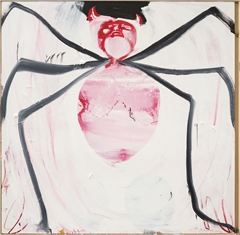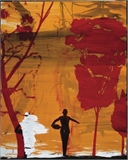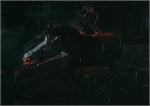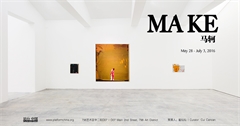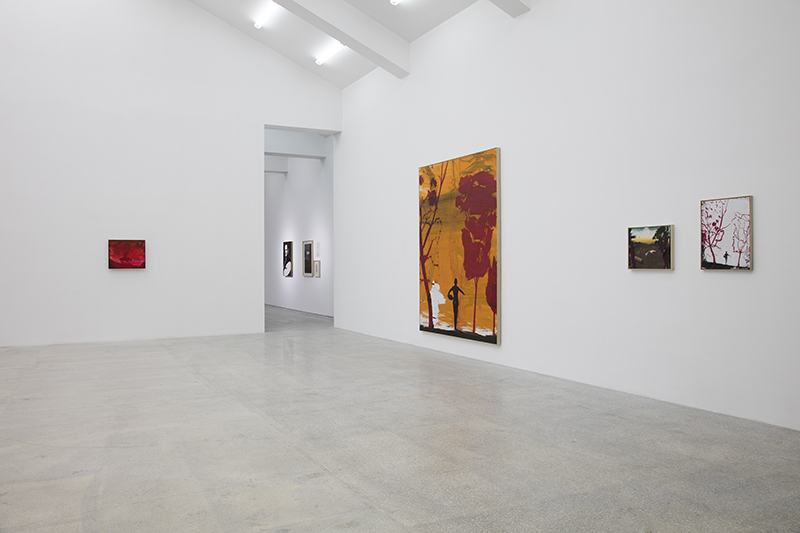
Things were not like this from the beginning. As the exhibition draws to a close, Ma Ke stands amidst his works spanning many years, and writes, “The power of a single stroke lays barea thousandbrushstrokes.” For some, this will evoke that image of the red hero blaring his trumpet on horseback at the entrance to the exhibition hall. A twist, a turn, a seemingly simple action, like the first ripples sent out by a stone cast into the water.
An exhibition is like a film. The path from beginning to end is bisected by many turns and foreign lands. Each shift in perspective, or twist in the narrative, leads to a different ending, a different landing on the other shore. It is only at the very end that the true image of the protagonist fully emerges.
The exhibition begins with the somewhat small painting God of Wine, rendered in simple, coarse brushstrokes and a powerful air of heroism that sets the tone for the entire exhibition. On the back of that wall, a series of similar God of Wine images are hung in the classic European multiptych form, each image connected, the parts forming a unified whole. The emphasis here is not on the repetition of images but on the antithetical relationship between works, their different origin points and diverging paths, though their spiritual orientation is the same. They are like the tightly wound body of Sisyphus in the moment of raising the boulder, attempting to rise above the great boulder and the painful labors of the flesh. The human spirit is always more solid than the stone.
The front and back are connected by the piece Flames of War at the juncture between two walls, its thick paint capturing the force of the artist’s action and the firmness of his resolution. The God of Wine series concludes with a bulky artwork. The sky in this painting is wider, the branches swaying as orbs of color drift about.
Each painting in this multiptych is an independent instance. Each contains distinctive brushwork, markings and details, each belonging to its own spatiotemporal reality and emotions. Yet when they are arranged together, they play off one another, the independent touches gathering together to form a complete narrative. In the folds of time and space, the artist repeatedly affirms his stubborn attachment to the heroic stance with perfect, unwavering clarity.
The other shore is the goal of all departures. The two Other Shore series pull the narrative dimension of the exhibition from its metaphysical air back to the realm of the artist’s career. The artist carries his palette, his only weapon, as he sets out on his journey, casting a long shadow behind him. Where may he go? Before the last brushstroke is laid, the palette is merely a physical body, applying rigid layers of color. When the painting is complete, the “body” has completed its journey to the other side. Amidst all of this, the work Untitled offsets this atmosphere while recording a microcosm of the artist’s life. Ma Ke’s everyday experience is defined by his daily routine of travelling from the city to his Heiqiao studio. The dusk over the outskirts of the city casts multiple shadows of the artist over them, which, between projection and distance, depict a night filled with reality and shimmering stars.
On the other side of Other Shore, the exhibition provides another narrative dimension, one about paths and methods of progression. God of Wine 1, at two sides of the entrance, links together with two other artworks to create a formal progression. The use of the “orbs” in different works, the progressive shifts, and the intersecting and diverging structures bring a transition in the image’s discourse. It requires that the artist constantly reallocate the position and properties of the image within different times and spaces, to bestow it with new contents and substances of expression. It is only at this moment that the artist’s weapon can be truly called a weapon, and that painting can, in a specific setting, take on a wholly singular existence.
The above passage may seem complex and difficult to understand. I am aware that I must seek out more comparative relationships within Ma Ke’s artworks for further verification. Near the end of the exhibition hall, ten Spiders echo the chore of this “narrative.” The works are arranged in a disjunctive manner, with varying sizes. Some lean against the wall from the ground, some hang in the air, some are firmly affixed to the wall. The multiple spatial relationships are like a guide that attempts to interpret the subject that occurs within the exhibition.
Spider is Ma Ke’s self-portrait from a dream. Perhaps the symbolic meaning of the spider has already been greatly diminished in repeated depictions, leaving behind only a juncture for self-shaping and extension. This process has stretched for several years. The repeated emergence of the image of the spider seems like a record of an individual’s constant corrections. It gives us the opportunity to peer in on an artist, on the full progression of his shifting spirit and emotions. As the story unfolds, it becomes clear that these artworks do not follow a linear contextual logic, but instead form a mixed, overlapping and complex individual theater. It is like a, out-of-sync clock laying out the times and coordinates of each time zone. Its content stretches out across different spaces and times. At each ripple, the “spider” takes on new content, and reshapes its physical body.
“As Gregor Samsa awoke one morning out of restless dreams, he found himself in bed, transformed into a giant cockroach.” This is how Franz Kafka begins his Metamorphosis. The protagonist encounters many absurd things before realizing that this absurdity stems from his relationship to the world. It is only then that he begins to find himself.
Departures always have a root cause. Evidence and Ritual 3 are the only “others” in the exhibition. These works tease out Ma Ke’s longstanding spiritual condition and circumstances in reality, pulling the social properties concealed behind the visual appearance of the artworks out behind them. In a 2003 statement, Ma Ke writes, “My father hoped that I, too, would become a salaried art worker, but for me, painting became a way of escaping and resisting ordinary life … I was destined to be a seeker, one seeking the morals and roots of human conduct, seeking my own judgment, conscience and love, seeking my path out and what I originally was, and eventually becoming myself.” At that time, Ma Ke had left the system to become a purely free artist. Years later, he created these two artworks. The power and brutality represented by the uniforms create an image that echoes the gods who sealed Sisyphus’s fate, attempting to control all. Together with the small portraits that surround them, these works form a complete story, a story of opposition between faces and shadows, despots and nobodies, submission and departure that paints a metaphorical portrait of Ma Ke’s dual escape.
How to escape? It is not until we reach the end of the exhibition that we can clearly see the image of the protagonist. A silhouette that repeatedly emerges in the creations, a painter wielding a palette, his back turned to a winged angel as he writes, “The power of a single stroke lays bare a thousand brushstrokes.” He has guided all of the illusions, illusions of the roles he could possibly take on, the hero on horseback in God of Wine, the distant traveler in Other Shore, the plump spider, the orbs within the structure. A series of twists and turns, they are all linked from beginning to end.
After many ripples have risen, it seems as if we have gained insight into everything. It coincides with the rupture between man and the world, the division between actor and backdrop, the gulf between the hopeful spirit and the disappointing reality. Yet none of this is the significance of the painter’s existence. The significance of any person’s existence should be more than this. The individual’s true duty is to seek the self and transcend the self. Whether his other shore is painter or lunatic, oracle or criminal, it does not matter. He has always dedicated all of his heart and mind, never ceasing. Things have always been like this from the beginning.
Cui Cancan
May 16, 2016

